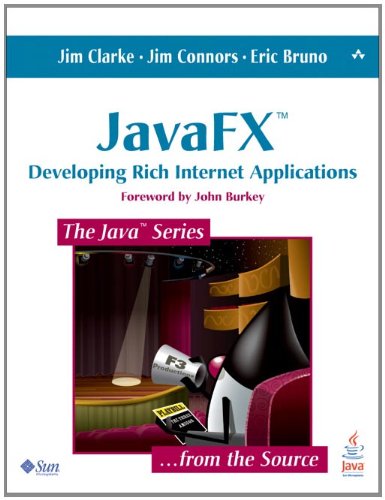(Ebook) JavaFX: Developing Rich Internet Applications by Jim Clarke, Jim Connors, Eric J. Bruno ISBN 9780137012879, 013701287X
Original review by Pasquale Granato, JUG Lugano [...]Approaching a book about a brand new technology can be dangerously misleading because you can end up to write about the latter instead to focus on the former. On the other side it's really hard to separate the two things but I swear that I'll do my best.Let's start talking about the book intended audience. The authors target the book to Java developers and to graphic designers as well. Probably people without a specific programming background will have some serious difficulties to follow many of the topics covered in the book. Speaking as a Java programmer I'd have appreciated more explanations where needed on the differences between Java and JavaFX script.(Personal annotation. I looked astonished for five minutes at this var num = if(sizeof args > 0) { java.lang.Integer.valueOf(args[0]); } else { 10; }before be acquainted with it. The JavaFX Script programming language is indeed an expression language, which means that everything, including loops, conditionals and even blocks, are expressions and can return a value.)The first two chapters of the book are devoted to set up the environments for both the programmers and the graphic designers. In a few pages it really makes clear how to get started using NetBeans or Eclipse (for programmers) and Photoshop or Illustrator (for graphic designers). Just to reassure you: yes, "Hello, world!" is the very first example of the book.In chapters three and four authors introduce the core of the JavaFX scripting language. Topics like sequences, expressions, binding and triggers are clearly covered with many short examples.After this boring but necessary stuff the fireworks begin. From the chapter five to eight the power of JavaFX is unleashed: the creation of cool and appealing user interfaces.The theater metaphor within the JavaFX user interface framework is really well covered. The reader will learn about the Stage, the Scene and the Nodes and how they combine as basic elements to make complex user interfaces. Special effects and animations are topics exceptionally well enlightened with clear descriptions, many examples, pictures and graphs.In comparison, the multimedia topic is covered extremely concisely. This is due to the fact that putting images and video in a JavaFX project is really simple. The publication of JavaFX project is an important topic covered in good detail in the chapter nine. The use of applet and Java Web Start as a way of publication is explained with many hints and with a cool paragraph about the integration between JavaFX and JavaScript. Unfortunately no attention is paid to other publication methods like mobile or television profile.An advanced topic, namely the creation of RESTful applications, is covered in chapter ten which presents an example widget that shows current weather conditions using data received form external web services. Java programmers will then be grateful for the chapter eleven, which covers in deep detail the integration between JavaFX and Java, with many tables about function parameter and return mapping and about type conversion mapping.A special mention should be deserved for the contents of the chapter twelve, JavaFX Code Recipes. In this chapter the authors present many code samples that will help the reader in several real world situation. For a new technology like JavaFX the value of being taught by the creators comes out in this advices that surely help to understand the language and to avoid the traps.In the last chapter of the book a complete Sudoku application is presented. This is an invaluable reference because all the range of topics are dissected, starting from the concept and the design, to the logic, to the interface. Many excerpts of code are analyzed START TRANSACTION WITH CONSISTENT SNAPSHOT; /* 2388 = 7dfa8ab1707c7bff173fbdc7963f9dae
*Free conversion of into popular formats such as PDF, DOCX, DOC, AZW, EPUB, and MOBI after payment.


